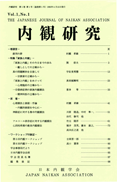Volume 19, Issue 1
Displaying 1-9 of 9 articles from this issue
- |<
- <
- 1
- >
- >|
OPENING REMARKS
-
2013Volume 19Issue 1 Pages 1
Published: September 25, 2013
Released on J-STAGE: September 25, 2021
Download PDF (906K)
CONCURRENT SESSION
-
2013Volume 19Issue 1 Pages 3-11
Published: September 25, 2013
Released on J-STAGE: September 25, 2021
Download PDF (1020K) -
Exploring the Characteristics and Possibilities of Naikan Psychotherapy from an Integral Perspective2013Volume 19Issue 1 Pages 13-25
Published: September 25, 2013
Released on J-STAGE: September 25, 2021
Download PDF (1482K)
MAIN SYMPOSIUM
-
2013Volume 19Issue 1 Pages 27-30
Published: September 25, 2013
Released on J-STAGE: September 25, 2021
Download PDF (1092K)
CASE REPORT
-
2013Volume 19Issue 1 Pages 31-41
Published: September 25, 2013
Released on J-STAGE: September 25, 2021
Download PDF (1026K)
SHORT REPORTS
-
2013Volume 19Issue 1 Pages 43-55
Published: September 25, 2013
Released on J-STAGE: September 25, 2021
Download PDF (1155K) -
2013Volume 19Issue 1 Pages 57-64
Published: September 25, 2013
Released on J-STAGE: September 25, 2021
Download PDF (1188K) -
2013Volume 19Issue 1 Pages 65-77
Published: September 25, 2013
Released on J-STAGE: September 25, 2021
Download PDF (1176K)
REPORT
-
2013Volume 19Issue 1 Pages 79-83
Published: September 25, 2013
Released on J-STAGE: September 25, 2021
Download PDF (1206K)
- |<
- <
- 1
- >
- >|
